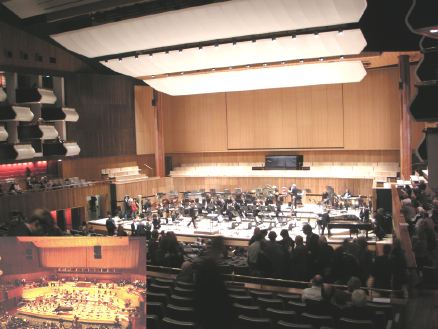
BACK TO THE RFH The refurbished Royal Festival Hall: inset, the hall in November 2000. Click here for a large version of the picture. Yesterday was my first visit to a concert at the Royal Festival Hall since the two-year refurbishment. Earlier in the evening a lecture on the changes to the hall's acoustic treatment was given by Larry Kirkegaard, President of the firm responsible for the acoustic redesign. Ever since the hall opened in 1951 the acoustic has been the subject of much debate: hated by musicians (who had difficulty hearing themselves) and disliked by much of the audience. The original designers (and there had been a deliberate attempts to create a specific acoustic) seem to have attempted to damp down reflected sound as much as possible: most of the wall panels resonated on mid and lower frequencies (thus absorbing instead of reflecting them), leading to a detailed but rather dead and bass-light sound. From the 'sweet spot' in the centre of the stalls the sound was remarkable - very detailed and clear if a little hard: but under the balcony and at the back of the balcony it was boxy and lifeless. Numerous changes were made to the construction. The canopy over the stage, originally wood and highly reflective, was replaced with one made from a fireproof fabric similar to canvas: its sections can be tilted, or raised and lowered to suit the type of concert. The wall panelling is now mostly solid backed and hence reflective: the auditorium floor is now wood instead of carpeted. The choir seating is now higher, giving a higher rear wall to the stage: the organ console has been moved back (the organ itself is still not fully reinstalled, and will be behind the rear panelling, which slides aside to reveal it). Sections of the stage can be raised or lowered to suit the requirements of the performers. The overall result is a 20% increase in reverberation (amount rather than duration, though this is slightly increased) at mid frequencies, and 40% at low frequencies. More sound now gets back to the musicians (as does any shuffling or coughing made by the audience). There is also more leg room in the seating, which is very welcome. Ironically, the Public Address system used during the lecture was appallingly bad, making some of what was said almost unintelligible: when, during subsequent questions, the speaker was asked to stop using the microphone he was immediately completely clear. More work needed here. So to the concert: in this essay I'm more concerned with the acoustics than the performances, which were to a high standard. Henze's Adagio, Fuge and Mänadentanz (drawn from his opera The Bassarids) and Beethoven's Ninth Symphony gave an excellent opportunity to assess the sound; the Philharmonia Orchestra was conducted by Christoph von Dohnányi. Sitting in the stalls, about a quarter of the way across and half-way back, the sound is slightly quieter than before (the reflections from the original canopy could make it very loud indeed). The sound is definitely warmer, with more bass (though the extreme bass is not as strong as in, for example, the smaller Cadogan Hall): there is still a good deal of detail, if perhaps not quite as vivid as before, but the additional reverberation has been achieved without smearing the internal details of the music. The slight hardness and edge to the sound has gone, making for easier listening. The acousticians are still fine-tuning it, but so far the results are a considerable improvement. Posted by Roger Wilmut 26th September 2007, 1107 a.m. | Return to weblog |
Quick Links
About
Me:
Roger Wilmut XML/RSS Feed
MY PODCAST
Archives
Calendar
Blogroll
Statistics
|
||||||||||||||||||||||



